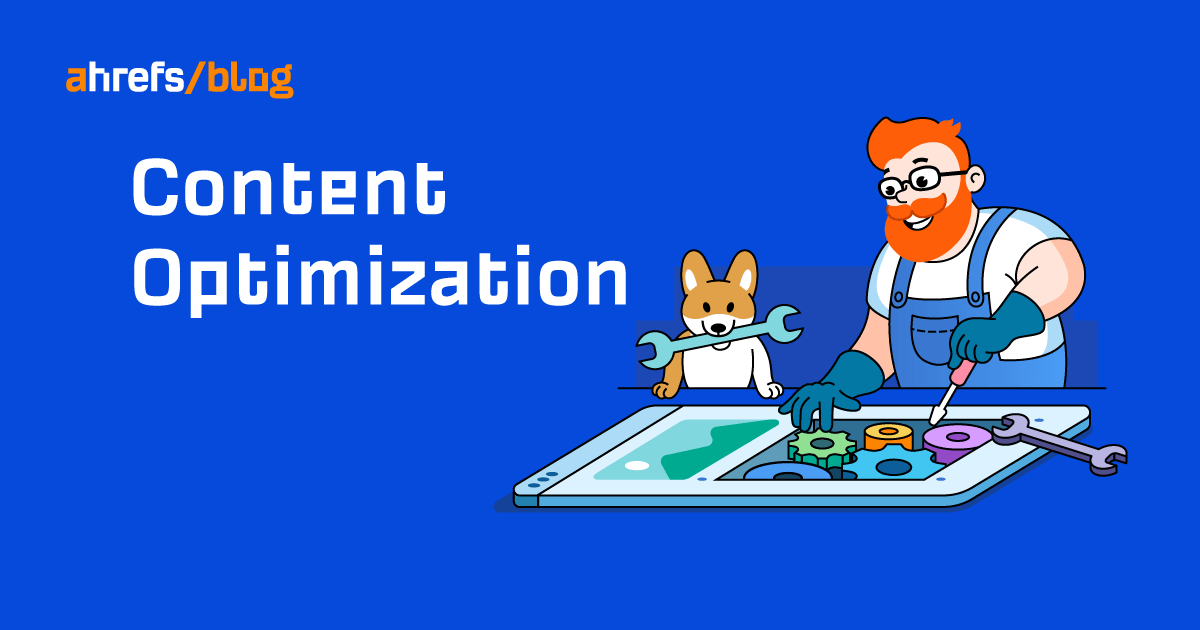SEO
Content Optimization: The Complete Guide

Content optimization helps you get more out of your content efforts, but you don’t necessarily need to make the same optimizations as everyone else. It depends on your goal.
In this guide, you’ll learn how to optimize content for SEO, conversions, and social shares.
But first, let’s make sure we’re on the same page…
Content optimization is the process of improving content to ensure it stands the best possible chance of meeting its desired goal. That may be ranking on the first page of Google, increasing social shares, or attracting your best customers.
Content optimization dramatically improves your content’s performance and helps you meet your marketing goals.
Without it, you miss out on visibility, rankings, traffic, leads, and sales.
The challenge is that the optimization techniques that move the needle forward aren’t always immediately apparent.
For instance, optimizing content for SEO vs. conversions requires two very different approaches. The former involves keyword research, while the latter involves copywriting and a product-led approach.
Before you think about attracting email subscribers or leads for your business, you need to start from the top. So let’s look at the different ways you can optimize your content for SEO and get traffic to your site consistently.
1. Make sure you’re targeting a keyword with traffic potential
Optimizing for a keyword that nobody searches for is pointless. Even if you rank #1, you won’t get any traffic.
To identify keywords with high traffic potential, here’s what you should do:
- Go to Ahrefs’ Keywords Explorer
- Enter one or multiple broad keywords related to your topic
- Hit Search
For example, when you enter “content marketing” and check the Matching terms report, you’ll get around 26,000 keyword ideas with search volumes, Keyword Difficulty (KD), and other valuable data:

To ensure that you’re finding keywords with the potential to attract traffic from organic search, add a minimum Traffic Potential filter. This metric shows the estimated monthly organic traffic to the current top-ranking page, so it’s a reasonable estimate of how much traffic you can get by ranking in pole position.

If your website is new and has low authority, it also pays to filter for low-KD keywords to unearth less competitive topics.

Recommended Reading: How to Do Keyword Research for SEO
2. Make sure it aligns with search intent
Unless your content aligns with what searchers are looking for, you’re dead in the water before you start. That’s because Google prioritizes search intent. If your content fails to answer searchers’ questions, this is a signal that your content is a poor match for the query and doesn’t deserve to rank.
The easiest way to understand search intent is to use the current top-ranking results as a proxy. Specifically, you can analyze them for the three Cs of search intent:
- Content type – The type of content on the SERPs (e.g., blog post, product page, landing page, category page). If the top 10 positions for your keyword show blog posts, stick to blog posts. Don’t try to shoehorn your product page into the SERPs; it won’t work!
- Content format – The content format in the search results (e.g., how-to, step-by-step guide, listicle, review). The top-competing posts will indicate what the searcher predominantly wants to know. If the first page of Google shows listicles, go with a listicle. If it shows guides, go with a guide. You get the idea.
- Content angle – The unique selling point of the competing content on the SERPs (e.g., discounts, inexpensive strategies, free shipping). While it’s crucial to stand out from the competition, you should still consider the similarities between top-ranking posts.
For example, if we look at the search results for the keyword “seo tips,” we see that the content type is blog post, the content format is listicle, and the dominant content angle is traffic boosting:

If you want to stand the best chance of ranking for this query, you should follow suit.
This is what we did with our list of SEO tips.
Recommended Reading: Searcher Intent: The Overlooked ‘Ranking Factor’ You Should Be Optimizing For
3. Make sure it covers everything searchers want to know
Does your post stack up against the competition?
Conduct a content gap analysis to see how you fare. The idea here is to identify potentially missing subtopics that searchers want to know and brainstorm how you can do better.
You can do this quickly by examining the three top-ranking posts most similar to yours (i.e., you may want to ignore that random landing page at the second spot if you’re writing a how-to guide):
- Paste the URL of your page into Ahrefs’ Site Explorer
- Go to the Content Gap tool
- Enter the URLs of the top three posts for your keyword
- Click Show keywords
For example, if we plug in our guide to guest blogging and a few similar top-ranking pages, one subtopic jumps out right away: a definition.

We don’t rank for this because we do not have a definition on our page, so it’d probably be best if we added one.
4. Make sure it’s easy and enticing to read
Most people don’t read webpages from beginning to end. Instead, they scan the main points and pick out phrases that jump at them.
Here are four practical ways to make your content more enticing and easier to skim:
- Eliminate fluff – Clichés, low-impact adverbs, and hard-to-read sentences repel users. Before publishing your post, use the Hemingway Editor, Grammarly, or ProWritingAid to catch these errors.
- Increase visual comprehension – Long walls of text overwhelm readers. Use short paragraphs and bullet points (like what we’re doing here), have bold key takeaways, and include relevant images to make your post more reader-friendly.
- Add a table of contents (ToC) in long posts – The ToC offers easy navigation and tells readers the list of topics covered.
- Prioritize important information – A well-optimized post makes valuable information accessible. Don’t make readers dig through them! Put your best ideas at the top. Leave the nice-to-know information at the bottom.
You’ll notice that we’re doing many of these things in this post. For example, if you’re reading this on desktop, there should be a floating ToC on the left:

Recommended reading: SEO Copywriting: 12 Easy Tips for Better Content and Higher Rankings
5. Make sure it has a compelling title tag and description
The title tag and meta description is the first thing searchers see on the SERPs.
Ideally, they should describe what your content is about at a glance. It’s a bonus if they set your post apart from competing posts. (This goes back to our point on content angle earlier!)
Here are a few tips to keep in mind when writing them:
- Match search intent – It should be clear that your page matches what the searcher is looking for from your title tag and meta description alone.
- Keep them short and sweet – Google truncates title tags and meta descriptions after a certain length. This is usually around 70 characters for title tags and 120 characters for meta descriptions, although it varies.
- Include your keyword – This helps searchers see at a glance that your page is a relevant match to their search.
- Highlight specificity – Specific data points increase credibility and respect. Compare “How to Attract Customers in a Month” with “How to Attract 2,738 Customers in a Month on a Shoestring Budget.” Which compels you to click more?
6. Make sure it has enough backlinks
Backlinks help you get into Google’s good books, as they’re one of the top three ranking factors.
Our search traffic study discovered that the more backlinks a page has, the more organic traffic it attracts. The graph below shows the trend between monthly organic search traffic and the number of backlinks from external websites (referring domains).

So if you want to rank high on the SERPs, you’ll need to build links from authoritative and relevant websites.
Here’s an easy way to find the number of websites that link to your page:
- Go to Site Explorer
- Enter your page URL
- Hit Search
You’ll see the number of referring domains on the Overview report.

You can then plug your keyword into Keywords Explorer and check the KD score to see if you have anywhere near the estimated number of referring domains needed to rank in the top 10:

If this number is way higher than the number of referring domains to your page, that may be what’s holding you back.
SEO may bring you lots of targeted traffic, but that traffic will be useless if your content doesn’t convert. And the trick to doing this is to pair product-focused content with snazzy copywriting skills that pack a punch. So let’s go through how to do that.
1. Make sure it targets a keyword with business potential
The true mark of content marketing success is not ranking on the first page on Google. It’s ranking and attracting a steady stream of leads and sales.
Unfortunately, many businesses create mountains of blog posts without considering the business potential of their keyword or topic.
You’ve probably seen these posts lurking around. They’re often about topics that have nothing to do with the business’s product, and they always end with a pushy call to action (CTA) that serves zero value to the reader.
That’s why it’s crucial to target keywords or topics that align with your product.
Here at Ahrefs, we always consider a keyword’s “business potential” score. The higher it is, the better the opportunity to position our product as an irreplaceable solution to the reader’s problem.
Here’s the scale we use:

This brings us to the million-dollar question: How do you position your product as the best solution so that readers will choose you over your competitors?
2. Make sure it shows your product in action
As marketers, our job is only half done if we target keywords with business potential but fail to educate prospects on how our product works. After all, that’s the whole point of choosing topics with high business potential.
But you shouldn’t just tell readers how your product works—you need to show them.
That’s what we’re doing in this post. Notice how we demonstrate how our SEO toolset helps you optimize your content? You’ll probably hit the “X” button if we make a blatant statement like “Ahrefs optimizes your content with a few clicks” without backing it up with proof.
3. Make sure it includes a persuasive call to action
It’s a pity to leave readers hanging after they read a post, especially when it drives massive value.
Include an irresistible CTA to encourage readers to take action toward solving their problems—whether it’s subscribing to an email list, booking a free consultation call, or even something as basic as leaving a question in the comment box.
What makes a CTA powerful? We boil it down to:
- Emotion – Conversion-driven CTAs speak to the prospect’s pain or goals and immediately trigger action. Your CTA should make them go, “This company gets me.”
- Credibility – With trust comes sales. Appeal to skeptical buyers with social proof like specific data, testimonials, and expert endorsements.
- Timing – Effective CTAs align where the prospect is in the buyer’s journey. Don’t be afraid to pepper them throughout the post.
Here’s a powerful CTA from Cognitive FX that ticks all the boxes:

Note how the treatment center adds an empathetic touch to a post about concussion memory loss in its CTA. It also leverages its impressive results (“on average, our patients improve by 75%”) to instill confidence.
Furthermore, look at the strategic placement of the CTAs.
Cognitive FX places them after setting the stage for the patients’ recovery journey, which strikes an emotional chord with readers.
Recommended Reading: RADically Rethink Your CTAs
The more people share your post, the more eyeballs it gets. So, in this last section, let’s look at how you can increase exposure on social networks.
1. Make sure it includes expert quotes
Unique quotes from subject matter experts boost distribution.
When you feature a source in your post, odds are they will want to share the post when it gets published. Plus, not only do you bake organic distribution directly into your content, but you also back up your claims without conducting additional research.
When Fio Dossetto, creator of ContentFolks, was writing a guide on content marketing for Ahrefs, she approached 14 marketing leaders for their insights. Many of these leaders shared the post with their followers after it went live.
Here’s Louis Grenier, founder of Everyone Hates Marketers, sharing it on Twitter:
My advice to create successful content in 2021 (or any year, really).
Thank you @content101 and @ahrefs for the feature.
👉 https://t.co/3jKS5ZK4w2 pic.twitter.com/FbMd3wTyMW
— Louis Grenier (@LouisSlices) January 27, 2021
Fio’s post generated 127 tweets and 161 backlinks as of today.
TIP
Even if the experts you feature have a smaller following, you can still replicate this technique. Databox, a business intelligence platform, tags them on LinkedIn, further amplifying the reach of its posts.
To make this work, you must first identify the right experts.
Even though platforms like HARO connect you with sources, watch out. Most of them are affiliate marketers with irrelevant expertise looking for backlinks.
A better approach is to look for subject matter experts using Ahrefs:
- Go to Ahrefs’ Content Explorer
- Enter your article’s topic
- Click the Authors tab
Identify experts who have written extensively about the topic and have a lot of followers. For example, we may reach out to Jonas Sickler and Caroline Forsey for a quick quote if we’re writing a piece on content marketing examples.

2. Make sure your social share buttons are visible at all times
Given that most readers won’t make it to the end of the post, it’s not an exaggeration to say that they will most likely ignore the social share buttons at the bottom.
This is where sticky share buttons from tools like AddThis and Sumo come in handy.
Since these anchored buttons stay on the screen while the reader scrolls, they’re more likely to notice, click, and share the post.
That’s what we do here at Ahrefs:

Readers can easily share our posts with a click instead of scrolling down to locate the elusive button—or worse, copying and pasting the URL on their social media channels.
Final thoughts
Optimizing content is like using the rocket start technique on Mario Kart. It helps you power up, gain a running start, and get the most out of your content efforts.
Try the tips above to rank higher on the SERPs, increase social shares, and attract your best customers.
Got questions? Ping me on Twitter.



















You must be logged in to post a comment Login